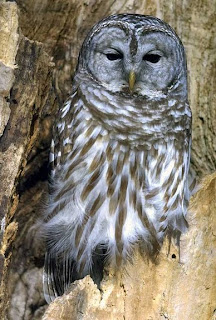Origin and Evolution of Birds
What was our definition of a bird?
Many modern vertebrate zoologists would change that to: "reptiles with feathers." Indeed, one researcher claims that birds are all that is left over from the dinosaurs--he holds for various reasons that many dinosaurs were warm-blooded. It could be that we don't have bird feeders but dinosaur feeders in our backyards. There should be a lot of material on the Internet on birds and dinosaurs. Try Googling the debate.
In any case, reptiles and birds (esp. crocodiles and birds) share a great number of features--so many that there can be little doubt but that they are closely related to the point that they once shared common ancestors. This common ancestor is thought to be THECODONT dinosaurs back in the TRIASSIC period of the geologic time scale 225 million years ago. (I once asked for the geologic time scale for extra credit-another mark of an educated person.)
1) skeletons similar: joints between skull and jaw the same in crocs and birds; ankle joints also similar
2) both have scales on epidermis & lack skin glands
3) brain structure is similar
4) blood proteins and red blood cell's are similar
5) embryological development is similar
6) hard-shelled eggs
7) fossil record
There are 2 theories about the evolution of flight (and whether Archaeopteryx, the first bird we know of, could fly). Traditionally, Archaeoperyx was thought to be arboreal and agile --a jumper and a glider that couldn't fly, just an arboreal gliding 2-legged dinosaur. John Ostrum (Yale) decided Archaeopteryx was not arboreal but cursorial. The skeleton does not indicate a climber or a glider but a bipedal animal that captured prey with forelimbs. Feathers evolved for heat conservation (like fur): Jurassic temperatures were cooling. SO WHY WERE THERE WING FEATHERS? By flapping proto-wings, the birds could generate lift for higher and higher jumps after prey.Whatever the case, birds are poorly represented in the fossil record and there are few avian paleontologists.
9000 species are alive today, in 30 orders, and 150 families. In addition, there are extinct fossils.You should be familar with the scientific names of the orders of the birds you see.
The class Aves peaked in the Pleistocene (about a million years ago). Madagascar had elephant birds = 1000 lbs and 2 gallon eggs. South American had 6' tall birds with foot-long bills that ate deer and pigs. California had vultures with 17' wing spans. New Zealand had Moas 12 feet tall.
Flight is the #1 reason birds are successful. Another reason birds are successful is thermal regulation. They are able to control enzyme reactions for maximum rate. This gave them a competitive advantage, especially when it got really cold at the end of the Mesozoic era
Many modern vertebrate zoologists would change that to: "reptiles with feathers." Indeed, one researcher claims that birds are all that is left over from the dinosaurs--he holds for various reasons that many dinosaurs were warm-blooded. It could be that we don't have bird feeders but dinosaur feeders in our backyards. There should be a lot of material on the Internet on birds and dinosaurs. Try Googling the debate.
In any case, reptiles and birds (esp. crocodiles and birds) share a great number of features--so many that there can be little doubt but that they are closely related to the point that they once shared common ancestors. This common ancestor is thought to be THECODONT dinosaurs back in the TRIASSIC period of the geologic time scale 225 million years ago. (I once asked for the geologic time scale for extra credit-another mark of an educated person.)
1) skeletons similar: joints between skull and jaw the same in crocs and birds; ankle joints also similar
2) both have scales on epidermis & lack skin glands
3) brain structure is similar
4) blood proteins and red blood cell's are similar
5) embryological development is similar
6) hard-shelled eggs
7) fossil record
There are 2 theories about the evolution of flight (and whether Archaeopteryx, the first bird we know of, could fly). Traditionally, Archaeoperyx was thought to be arboreal and agile --a jumper and a glider that couldn't fly, just an arboreal gliding 2-legged dinosaur. John Ostrum (Yale) decided Archaeopteryx was not arboreal but cursorial. The skeleton does not indicate a climber or a glider but a bipedal animal that captured prey with forelimbs. Feathers evolved for heat conservation (like fur): Jurassic temperatures were cooling. SO WHY WERE THERE WING FEATHERS? By flapping proto-wings, the birds could generate lift for higher and higher jumps after prey.Whatever the case, birds are poorly represented in the fossil record and there are few avian paleontologists.
9000 species are alive today, in 30 orders, and 150 families. In addition, there are extinct fossils.You should be familar with the scientific names of the orders of the birds you see.
The class Aves peaked in the Pleistocene (about a million years ago). Madagascar had elephant birds = 1000 lbs and 2 gallon eggs. South American had 6' tall birds with foot-long bills that ate deer and pigs. California had vultures with 17' wing spans. New Zealand had Moas 12 feet tall.
Flight is the #1 reason birds are successful. Another reason birds are successful is thermal regulation. They are able to control enzyme reactions for maximum rate. This gave them a competitive advantage, especially when it got really cold at the end of the Mesozoic era



Comments
Post a Comment